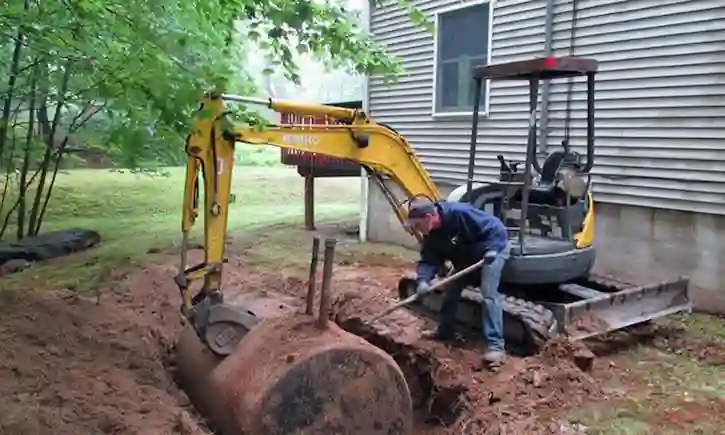
Beneath the surface of many homes, buried treasures of the past can turn into environmental time bombs – aging oil tanks. Understanding the oil tank removal process is crucial for homeowners looking to address potential hazards, comply with regulations, and ensure the safety of their property and the surrounding environment. In this comprehensive guide, we will dig deeper into the intricacies of the oil tank removal process, unraveling each step to provide homeowners with a clear understanding of this vital undertaking.
1.Initial Assessment:
The journey of oil tank removal begins with a thorough initial assessment. Homeowners, often with the assistance of professionals, locate and inspect the oil tank for signs of aging, corrosion, and potential leaks. This assessment serves as the foundation for determining the scope of the removal process.
2.Legal Compliance:
Understanding and complying with local and state regulations is a fundamental aspect of the oil tank removal process. Regulatory requirements often dictate the proper installation, maintenance, and removal of underground storage tanks, including oil tanks. Compliance ensures that the removal process is not only safe but also avoids potential legal consequences.
3.Timing is Key:
Determining the right time for oil tank removal is crucial. Proactive homeowners often choose to remove tanks before they reach the end of their expected lifespan or show signs of deterioration. Early removal helps prevent potential leaks and environmental damage. However, if a tank is already exhibiting issues, immediate action is necessary to mitigate risks effectively.
4.Professional Assistance:
Oil tank removal is a complex task that requires professional expertise. Certified tank removal experts possess the knowledge, experience, and specialized equipment needed for a safe and efficient process. Attempting to remove an oil tank without professional assistance not only poses risks to the property and the environment but may also lead to legal complications. Hiring professionals ensures compliance with regulations and minimizes potential accidents.
5.Comprehensive Site Assessment:
Before initiating the removal process, a comprehensive site assessment is conducted. This involves locating the tank, evaluating its condition, and determining potential environmental impact. Soil and groundwater testing may be necessary to identify any contamination. A thorough site assessment guides theremoval process and helps in planning for any necessary remediation.
6.Tank Pumping and Cleaning:
The removal process begins with the safe pumping and cleaning of the tank. Any remaining oil is extracted, and the interior of the tank is thoroughly cleaned to minimize the risk of spills during extraction. Proper disposal of the extracted oil is crucial to prevent environmental contamination, marking a key step in the overall process.
7.Excavation:
If the decision is made to completely remove the oil tank, excavation becomes a critical phase. The area surrounding the tank is excavated to fully expose it, allowing for a detailed inspection. Specialized equipment is then used to carefully lift the tank from its underground location. Precision is paramount during excavation to avoid damage to the tank and surrounding structures.
8.Environmental Remediation:
In cases where soil or groundwater contamination is detected during the removal process, environmental remediation measures are implemented. Remediation may include the removal and replacement of contaminated soil or advanced treatments for groundwater. This step is essential for mitigating the environmental impact of the oil tank and ensuring regulatory compliance.
9.Documentation and Reporting:
The final step in the oil tank removal process involves comprehensive documentation and reporting. Homeowners receive a detailed report outlining the entire removal process, environmental assessments, and any remediation activities. This documentation is crucial for proving compliance with regulations and serves as a record of responsible environmental stewardship.
Conclusion:
Digging deeper into the oil tank removal process unveils a journey that requires careful planning, professional assistance, and a commitment to environmental responsibility. By understanding each step – from the initial assessment to comprehensive site evaluations, safe tank pumping, excavation, and environmental remediation – homeowners can navigate the complexities of oil tank removal with confidence. This process not only ensures the safety of the property and the environment but also reflects a conscientious approach to maintaining a home that stands the test of time.
Related posts:


Forex & Crypto
5 Best Ways to Earn Crypto While You Sleep in 2025
Categories
- Apps (1)
- Automotive (23)
- Beauty (7)
- Business (122)
- Celebrities (2)
- Digital Marketing (21)
- Ecommerce (2)
- Education (22)
- Entertainment (39)
- Events (6)
- Fashion (1)
- Features (4)
- Finance (1)
- Fitness (10)
- Food (2)
- Forex & Crypto (23)
- General (116)
- Health (48)
- House (61)
- Lifestyle (57)
- Marketing (8)
- Parenting (3)
- Pets (10)
- Real Estate (8)
- Safety and Security (14)
- Social Media (31)
- Sports (142)
- Technology (73)
- Travel (23)






















